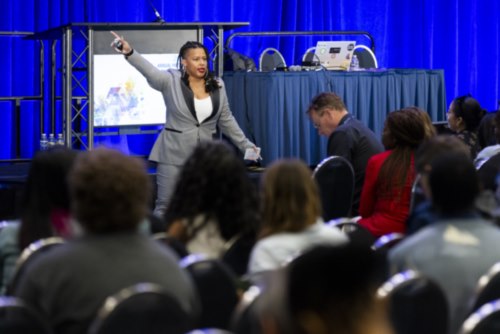By Crystal M. Watson

The word “belonging” is emerging as yet another buzzword in education and that must be acknowledged. Keeping the authenticity and organic nature of what it means to belong in a mathematics space is top of mind for me and many other scholars.
In the closing keynote at the NCTM 2023 Annual Meeting in Washington, DC, I introduced the Five Factors of Belonging based on the many conversations I’ve had with youth over the years. While each district, school, and classroom has its own climate and culture that impacts the sense of belonging, according to children that I have had the privilege of working alongside, there are some seemingly simple but thoughtful ways we can impact academic, social, psychological, and emotional outcomes for children in mathematics.
1. You see me
To see each and every individual child takes intentionality and strategy as we continue to navigate overcrowded classrooms and an increase in the needs of children coupled with a decrease in services for those needs.
Try it: Stand at the door as youth transition into the space. Do it not as a check the box or just to say hello, but to actively check for mood, mindset, etc.
2. I see myself
An overly policed/quiet classroom can send a message that the youth’s stories and experiences do not matter once they cross the threshold. Even the most structured classrooms can plan for time where youth can see themselves as a valuable part of the math community. Let them talk!
Try it: Plan weekly circle time (yes, for all grades K-12) where youth have the opportunity to share their experiences in the learning.
3. Others see me
Imagine the last time you were in a space where you felt your contributions were not welcomed or like your ways of learning were an oddity to be managed. Now, think about a time when you felt seen as a contributor, even through your mistakes. To belong is to be able to find comfort in our contributions–small and large. It feels great to know we are not alone in our thinking, yea?
Try it: Every day find a way that youth share their thinking (not just their answers) with each other. Check out resources for “My Favorite Mistake” or “My Favorite No.”
4. I am valued
Perspective is so powerful. I think of the meme where the kitten sees themselves reflected back as a tiger. When we make space for multiple ways to show learning based on the needs of youth, we envoke power.
Try it: Choice boards!
5. I can grow
Much of our youth (and many of us) have been conditioned to think math is a “you got it or you don’t” type of content. We have to actively create counter narratives and counter experiences about math ability!
Try it: Tell stories of real people in real communities like their own. This might mean inviting community members in to share their experiences with mathematics and how they have grown to use it in meaningful ways.
Everyone deserves to see the ways mathematics can change the trajectory for them and that starts with openness to learning and persevering through it. Having a strong sense of belonging can only improve the odds of this, especially, for our most marginalized youth.
Want to chat? Reach out at
[email protected].